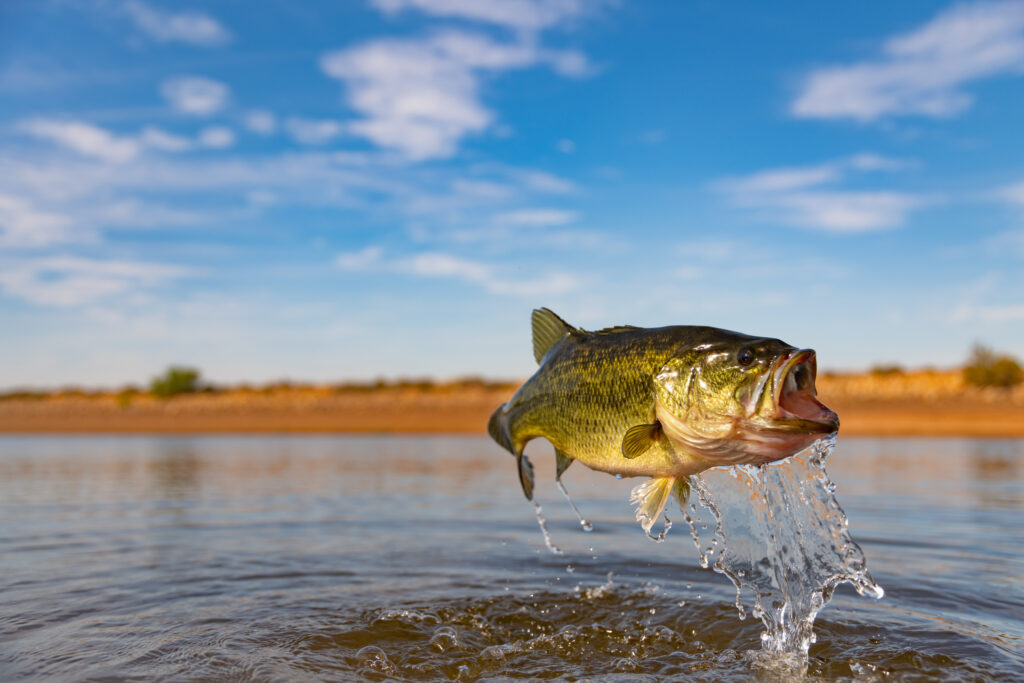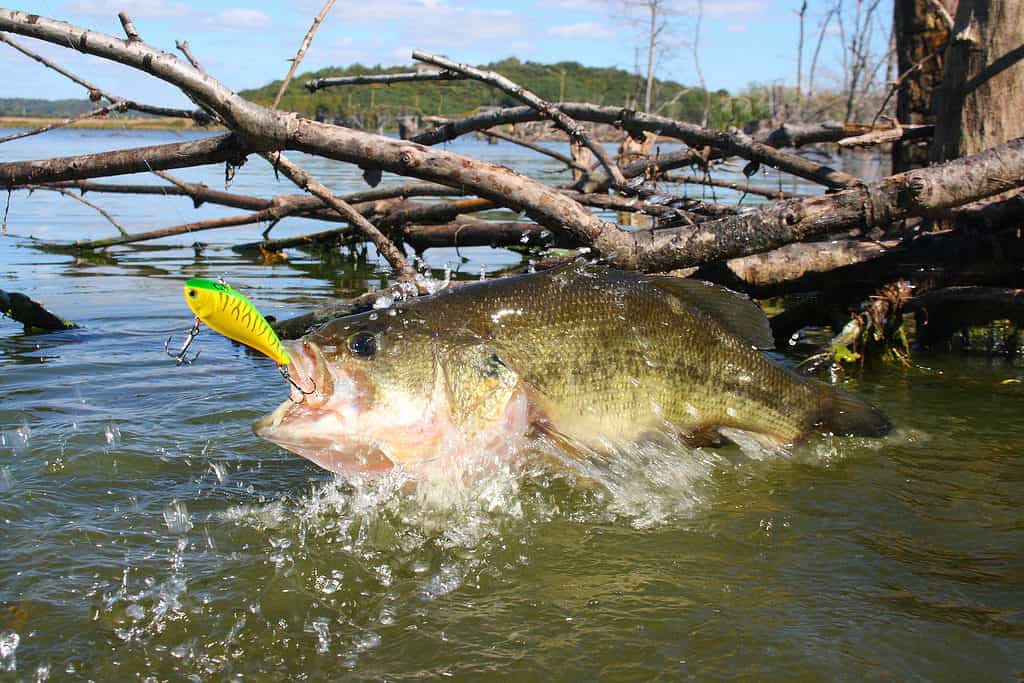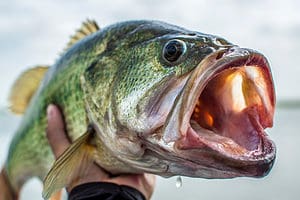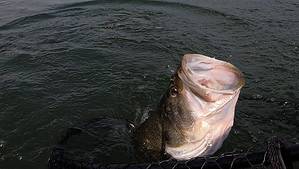Reeling in largemouth bass in general is pretty impressive, but accomplishing a record-breaking catch is truly special! Each U.S. state has its own official list of top anglers and their respective catches that earned them their unique spots in bass fishing history. So, what about the largest largemouth bass ever caught in Oklahoma? Read on to learn all about the Sooner State’s current record below. We’ll also look at how it compares to the world’s largest specimen!
Facts About The Incredible Largemouth Bass

Largemouth bass can be found throughout much of North America.
©Ryno Botha/Shutterstock.com
Native to much of North America, the largemouth bass is a hardy, resilient, and fearsome freshwater carnivore. It’s actually an apex predator, as very few animals prey upon it due to its massive size, swimming speed, and physical strength. It feeds on just about anything it can get into its enormous mouth! This includes small fish like perch, shad, and shiners, all manner of aquatic invertebrates, and other, smaller black bass species! Incredibly, it’ll occasionally even take a bite out of larger prey like snakes or alligator hatchlings if its usual menu is scarce.
As a member of the Micropterus genus, the largemouth is part of a group of 13 different species collectively known as the black basses. This makes it closely related to species like the smallmouth and redeye basses. It’s also the largest species in both the Micropterus genus. It’s also the largest member of its whole family, Centrarchidae, which consists of about 38 unique species.
Superficially, the largemouth resembles most other black basses aside from its increased size. Its body is a deep, olive green, typically with dark brown markings and a white belly. As a ray-finned fish, its thin fins are supported by rigid, bony rods. True to its name, it has a very large, wide mouth. Generally, females are larger than males. This is because they often carry large clutches of up to around 70,000 eggs at a time!
In addition to being the largest fish of its kind, this fascinating species also has one of the lengthiest lifespans of the black basses. It reaches sexual maturity quickly, at around one year old. On average, it lives 10 to 15 years. However, it isn’t uncommon for some individuals to reach 20 years old or more in optimal conditions.
How Big Do Largemouth Bass Get?

The average largemouth bass reaches between 14 and 20 inches long.
©iStock.com/stammphoto
So, how large does the largemouth actually get when it reaches its full size? Most mature black bass species average somewhere between 8 and 15 inches long. However, the largemouth bass is capable of growing to almost three feet in length! The majority of adult largemouths max out at roughly 14 to 20 inches long, though, so especially large individuals are rather rare.
In terms of its average weight, this fish is just as impressive. It’s heavier than all of its fellow black basses at anywhere from about 5 to 15 pounds, depending on many factors like sex, age, and diet in its particular habitat. In fact, especially heavy largemouths can sometimes exceed 20 pounds!
The largemouth bass doesn’t just look big, either–its body is extremely bulky, muscular, and powerful, making it a tough predator and speedy swimmer. It can swim up to 20 miles per hour, albeit only in short spurts. In addition, its strong, robust build makes it capable of taking down prey up to half the size of its own body with relative ease.
The Largemouth’s Impact On Bass Fishing

The history of the largemouth bass in fishing is long and storied, beginning with the advent of the steam engine.
©iStock.com/stammphoto
The largemouth bass is arguably the most sought-after black bass species among North American anglers, as well as in areas where the species has been introduced in more recent years, like Japan and parts of Europe. It has a long, storied history in the bass fishing hobby. However, the species really gained its reputation as a coveted game fish starting in the mid-1800s with, interestingly, the advent of the steam engine.
As steam engines needed lots of water to make long voyages across the states, tank ponds were established at certain waypoints to supply them. Towns quickly cropped up surrounding these waypoints. Locals stocked these ponds with largemouths, in part because the fish were hardy enough to tolerate long travels.
Initially, American anglers adapted techniques they used for catching fish like trout and salmon to catch largemouth bass. Fly fishing was common early on, with floating wooden lures becoming more prevalent in the early 1900s. Over time, anglers developed and experimented with other methods, and plastic worm lures became popular starting in the 1950s.
As plastic became cheaper and faster to produce, more varied techniques, lures, and baits entered the largemouth fishing scene. At around the same time, a post-war fishing boom occurred. North American anglers tailored their methods to suit black bass fishing. Colorful swimbaits became popular, as they effectively mimicked the species’ prey.
By the 1960s and ‘70s, tournaments dedicated to black basses–in particular large and smallmouths–were organized by bass fishing enthusiasts. In 1967, the B.A.S.S. Federation held its first competition. The Bassmaster Classic followed in 1971. Both tournaments are still going strong to this day! New techniques for largemouth bass fishing are being developed all the time, and the hobby is more prominent than ever both in the US and worldwide.
What Is The Largest Largemouth Bass Ever Caught In Oklahoma?
As we touched on at the beginning of this article, each U.S. state’s fishing and wildlife departments track their respective local fishing records. According to Oklahoma’s Department of Wildlife Conservation, the largest largemouth bass ever caught in the Sooner State was an impressive 14 pounds 13.7 ounces! Additionally, it was just over 26” inches long and boasted a 23-inch girth.
This current record was established on March 13th, 2013 by angler Dale Miller at Cedar Lake in LeFlore County. Local news sources like The Oklahoman state Miller managed to land the record-breaking fish with a swim bait on an Alabama rig.
For those less familiar with bass fishing, an Alabama rig is essentially a smaller, scaled-down version of the standard umbrella rig. Umbrella rigs are unique in that they mimic an entire school of swimming fish. They typically resemble schools of common prey fish.
Interestingly, Cedar Lake is a local hotspot for bass fishing and especially large largemouth specimens! Angler Benny Williams, Jr. landed the previous state record at the same spot around one year prior to Miller’s catch. Williams’ respective catch measured 14 pounds, 12 ounces, meaning Miller’s new record edged ahead by just 1.7 ounces.
What Is The Largest Largemouth Bass Ever Caught?
Although Dale Miller’s record-breaking largemouth bass is nothing short of awe-inspiring, the current world record is still roughly 8 pounds heavier! What’s interesting about this record is it wasn’t caught in North America where the species is native and most abundant. It was actually achieved by a Japanese fisherman!
On July 2nd, 2009, angler Manabu Kurita caught a 22-pound 4.97-ounce largemouth bass at Japan’s historic Lake Biwa. Lake Biwa is located northeast of Kyoto in the Shiga Prefecture and is Japan’s largest freshwater lake. It is home to a wide variety of game fish, including various black basses, bluegill, and, of course, the endemic Biwa trout.
But this story doesn’t end here. The current largemouth bass world record is technically shared by two people! This is due to an International Game Fish Association regulation that states record-breaking catches have to be more than 2 ounces larger than the previous record. Kurita’s record is only about one ounce larger than the previous record, which belongs to angler George W. Perry of Rentz, Georgia.
Amazingly, Perry’s record (which measured 22 pounds 4 ounces) was caught all the way back in 1932! Perry was only 19 years old at the time, and he reeled in the lucky catch at Montgomery Lake in Telfair County, Georgia. Sadly, he died in 1974, but to this day, his record still stands alongside Kurita’s. Montgomery Lake even has a historic marker nearby to commemorate and immortalize Perry’s record.
Where Is Oklahoma Located On A Map?
Cedar Lake is located in southeast Oklahoma, in LeFlore County, inside the Ouachita National Forest, and is considered a part of the Indian Nations National Scenic and Wildlife Area. Oklahoma is located between the Great Plains and the Ozark Mountains, near the geographical center of the United States, and is bordered by Texas to the south, Missouri and Arkansas to the east, Colorado and Kansas to the north, and New Mexico to the west.
The photo featured at the top of this post is © iStock.com/stammphoto
Thank you for reading! Have some feedback for us? Contact the AZ Animals editorial team.






